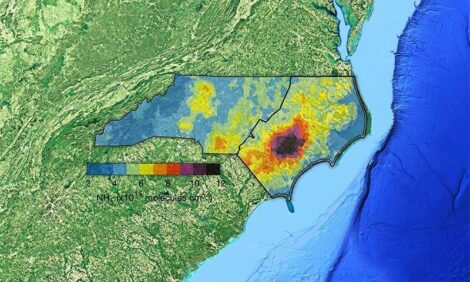



Review of the U.S Hog Market - March 2003
Our Monthly look at the trends in US Hog Market and what effect these may have on future prices - Written by James Mintert, Kansas State University.Overview
National average base prices averaged $47.11 (carcass weight) so far this year, down 10% compared to last year. National net prices during the same time frame averaged $49.62, also 10% below a year ago, while USDA’s estimate of the pork cutout value averaged $53.18, about 9% below a year ago.Unexpectedly large pork supplies are partly responsible for hog and pork prices falling below last year. Hog slaughter so far in 2003 has been 1.7% larger than a year ago and pork production has been 2% above a year ago.
This compares to expectations that slaughter during January-March would actually drop below (less than 1%) a year ago. Although some of the slaughter overrun is attributable to increases in sow slaughter and hog imports, it looks very much like USDA underestimated last summer’s pig crop.
The unexpected increase in slaughter this winter gives rise to concerns that slaughter this spring and summer could also be larger than originally forecast.
 |
 |
 |
Producers Still Liquidating Breeding Herd
Sow slaughter this year (through mid- February) has been 3.6% larger than last year.The ongoing rise in sow slaughter is consistent with USDA’s February (monthly) Hogs and Pigs report, which indicated the February 1 breeding herd was 3.5% smaller than a year ago.
On January 1 ,USDA estimated the breeding herd was 3.1% below 2002’s, which confirms some modest breeding herd liquidation took place during January. So, the fact that USDA’s survey revealed 3.4% fewer females were bred during January 2003 than a year earlier matches up well with both the January and February breeding herd inventories.
Sow farrowings fell 1.7% below a year ago during January, according to USDA’s monthly report. U.S. hog producers have farrowed fewer sows than in the previous year every month since June 2002. Pigs per litter changed little compared to the previous year (+0.1%), despite this winter’s cold weather. As a result, the January pig crop was about 1.5% smaller than a year ago.
USDA’s estimates of monthly pig crops imply that hog slaughter should be below, instead of above, last year’s level.
The September pig crop estimate implies that March slaughter should be down slightly (less than 1%) compared to last year. But slaughter estimates based upon subsequent pig crop estimates indicate slaughter during April and May should fall well below 2002’s.
For example, the October and November pig crops were 2.6% and 3.7% smaller than a year ago, which means hog slaughter during April and May should drop significantly this spring, unless the pig crops were underestimated.
USDA’s next quarterly Hogs and Pigs report, scheduled for release on March 28, will provide some new information regarding expected slaughter the rest of 2003.
 |
 |
Canadian Hog Inventories Rise
In contrast to the U.S., hog inventories are still growing in Canada. According to Statistics Canada the January 1, 2003 Canadian hog inventory was 2.5% larger and the breeding herd was up 3%, both compared to a year ago. Over the last five years, the average increase in Canada’s hog inventory was about 5%, so growth during 2002 was slower than in recent years.Pork Export Value Down in 2002
The value of U.S. pork exports declined 3% during 2002, compared to the prior year. It was the first time the value of U.S. pork exports declined since 1998 and only the fourth export decline since the mid-1980’s. In contrast, pork export tonnage actually rose modestly to 1.6 billion pounds, up 3.5% from 2001’s total of 1.56 billion pounds.Live hog imports from Canada rose 7.5% to 5.74 million head in 2002. All of the increase in hog imports was attributable to rising feeder pig imports. According to USDA, feeder pig imports rose 19% in 2003 compared to 2002. In contrast, slaughter hog imports actually fell 9% below the prior year.
 |
Hog Outlook
Hog prices in 2003 have been lower than forecast, in part because hog slaughter and pork production have been larger than expected.If prices are to strengthen in late winter and early spring, it will occur because slaughter and production finally start to drop back below year ago levels. Even so, it looks like national average base prices during January-March will average $47 to $48.
Prices are expected to improve during the spring quarter, but the rally’s magnitude will depend on how much slaughter and production fall. Last year, national base prices averaged $47.47 during the April-June quarter. This year prices should rise above a year ago, but the average is likely to wind up in the low to mid-$50’s, unless slaughter falls more than seems likely now.
Futures Based Cash Price Forecasts
Futures prices, adjusted for basis expectations, are a source of continuously updated cash price forecasts.As an example, Western Corn Belt barrow and gilt price forecasts based upon futures prices at the time of this writing (03/04/03) settlement prices) adjusted for basis expectations are included in a graphical format. Basis forecasts are based upon the most recent three-year average basis for Western Corn Belt barrows and gilts. To provide some indication of the amount of risk present, forecasts based upon the most positive and negative basis of the last three years are also included.
 |
Weekly updates (in graphical form) of these price forecasts are also available on the K-State Livestock & Meat Marketing Web Site (www.agecon.ksu.edu/livestock) in the weekly electronic publication entitled Hog Price & Supply Graphs.
Information provided by KSU Livestock report. For more information visit the KSU Livestock website.
Reproduced with permission.







